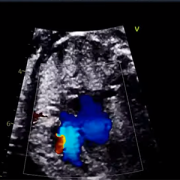Tetralogy of Fallot repair technique demonstrates low reoperation rates
Cardiac surgeons at Children’s National Hospital have used a uniform transventricular strategy for tetralogy of Fallot repair for more than 15 years. A large, retrospective study published in the Journal of Thoracic and Cardiovascular Surgery demonstrates that few patients who received a repair using this method required a reoperation to implant a pulmonary valve in the first 10 years after their primary repair surgery.
What it is
The study is one of the first to report statistically significant outcomes of the transventricular approach applied uniformly in a single institution. It provides tangible evidence of the short- and mid-term postoperative outcomes from 244 consecutive patients who underwent tetralogy of Fallot repair at Children’s National between 2004 and 2019. Infants received the repair between 42 and 106 days after birth.
Tetralogy of Fallot is a condition of several related congenital heart defects that occur due to abnormal development of the prenatal heart during the first eight weeks of pregnancy.
Why it matters
The data show that, at Children’s National, 96.7% of children who underwent tetralogy of Fallot repair within the first year of life using this transventricular approach were able to avoid having an additional surgery to receive a replacement pulmonary valve for up to a decade after their initial repair.
It also shows a benefit of this approach soon after birth. The authors believe that having the repair earlier (on average, 71 days after birth in this study) provides long-term benefits to the growth and development of both the brain and heart. The repair also protects the heart’s function over time by preventing the development of dangerous ventricular arrhythmias.
The big picture
Short- and mid-term post-surgical outcome data like the information presented in this study are an important indicator of the expertise, care quality and overall safety associated with the cardiac surgery team performing the procedure.
These findings provide critical insight into the effectiveness of specific treatment approaches for infants with tetralogy of Fallot and can help both clinicians and families better understand the benefits and risks of these procedures.
Read the full study in the Journal of Thoracic and Cardiovascular Surgery.










